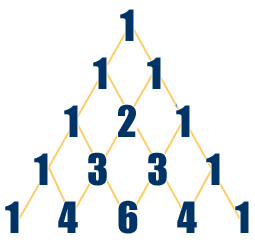Let's Begin With Addition
This section is all about addition. The rules of addition apply to any type of number you will find in math. We know you'll be asked to add whole numbers, decimals, and fractions. Eventually, you will use all of these skills in algebra and calculus. Addition is one of the core skills in all of math. In a nutshell, you take two values (sometimes more) and put them together. You add one thing to another.What's With That Triangle?
 That is a special triangle designed by a mathematician named Pascal. As you move down each level, you should notice three things...
That is a special triangle designed by a mathematician named Pascal. As you move down each level, you should notice three things...
(1) A "1" is attached on the ends of each new row.
(2) The middle numbers are the sum of the two numbers above. A sum is the result of any addition problem.
Look at row three. Do you see the "1-2-1?" That value of "2" is the sum of the ones from the previous row. (1+1 = 2)
(3) The sum of all of the numbers in each row doubles as you move down. Sum of Row 1 is 1 (1 = 1). Sum of Row 2 is 2 (1+1 = 2). Sum of Row 3 is 4 (1+2+1 = 4). Sum of Row 4 is 8 (1+3+3+1 = 8). Sum of Row 5 is 16 (1+4+6+4+1 = 16). The pattern will continue forever.
You may also see other patterns in the triangle. Notice the order of the numbers if you move diagonally. There's a lot to be learned from that little triangle. If you want to experiment, build your own triangle on a piece of paper and work it out for ten rows. The numbers will get big and you will see even more patterns.
Combining Values
Now you know that addition is about putting values together. We'll start with putting two values together, but you can add any number of values. You might have an addition problem with one thousand terms. People who use statistics use many, many values when they work on their projects.Can you wind up with less than you started? Yes. In some later sections, you will be adding positive and negative integers. Since negative numbers have values less than zero, you will wind up with a smaller number after the addition. You can't wind up with less in the real world. Math is the only place you can add two numbers and wind up with less than zero. The real world uses subtraction.
You will also find yourself grouping values. When you group addends (each term in an addition problem), you can do addition a lot faster.
Example:
1+2+3+1+2+3+1+2+3= ?
Group them with parentheses.
(1+1+1) + (2+2+2) + (3+3+3)
Can you see how much easier it is to add them when you group similar numbers? You are able to create collections of numbers that you understand. It's no different than when you group objects by shape or color. Similar numbers are often easier to work with.
Useful Reference Materials
Wikipedia:https://en.wikipedia.org/wiki/Arithmetic
Encyclopædia Britannica:
http://www.britannica.com/topic/arithmetic
Encyclopedia.com:
http://www.encyclopedia.com/topic/arithmetic.aspx





